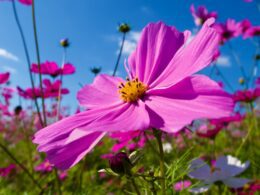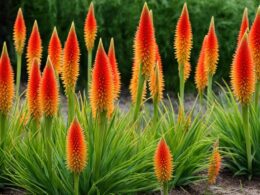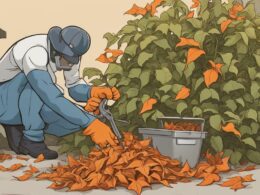Are you curious about whether snake plants can bloom? Well, the answer is yes! Snake plants, also known as Dracaena trifasciata or Sansevieria trifasciata, have the potential to produce beautiful flowers under certain conditions. While blooming is not very common, it is a sight to behold when it does happen.
Snake plant blooms typically occur during the spring growing season. If you want to encourage your snake plant to bloom, there are a few factors to consider. First, make sure you provide the plant with well-draining soil to prevent root rot. Snake plants also thrive in bright indirect light, so find a spot that offers optimal lighting conditions.
Another crucial aspect is maintaining the right temperature range of 50°F to 85°F. Extreme temperature changes can stress the plant and hinder flower production. To help create the ideal environment, water your snake plant infrequently, allowing the top layer of soil to dry out. This will simulate the semi-succulent nature of snake plants, which store water in their foliage.
Finally, keep in mind that older snake plants are more likely to bloom. As they become root bound or pot bound, the stress on the plant triggers flower production. So, be patient and give your snake plant the care it needs to thrive.
Stay tuned to discover more valuable information on factors that influence snake plant blooming and useful tips on how to encourage your snake plant to produce those stunning flowers.
Factors that Influence Snake Plant Blooming
Several factors can contribute to the blooming of snake plants.
- Well-draining soil: Using well-draining soil is important to prevent root rot and create optimal conditions for snake plant growth. This ensures that excess water can easily drain away, preventing waterlogged roots that can lead to plant stress and hinder flower production.
- Bright indirect light or full sun: Snake plants require adequate light to thrive and bloom. Place your snake plant in a location that receives bright indirect light or full sun for a few hours each day. This provides the necessary energy for the plant to produce flowers.
- Temperature: Maintain temperatures between 50°F and 85°F to create an optimal environment for snake plants. Avoid exposing the plant to extreme temperature changes, as this can cause stress and inhibit flowering.
- Infrequent watering: Snake plants are semi-succulents that store water in their foliage. It is important to water them infrequently to prevent overwatering and root rot. Only water when the top layer of soil is dry to the touch, ensuring that the plant receives enough moisture without becoming waterlogged.
- Age of the plant: Older snake plants are more likely to bloom compared to younger plants. This is because older plants are typically root bound or pot bound, which adds to the stress level and triggers flower production within the plant.
By understanding these factors and implementing proper snake plant care tips, you can create an environment that encourages blooming. Providing the right soil, light, temperature, and watering conditions will help your snake plant thrive and may eventually lead to the beautiful sight of its flowers.
How to Encourage Snake Plant Blooming
To promote flower growth in your snake plants, it’s essential to provide them with the right conditions. Follow these snake plant care tips to encourage blooming:
- Use well-draining soil: Opt for a well-draining soil mix that allows the roots to breathe and prevents overwatering. This will help maintain the right moisture balance, preventing root rot and promoting healthy growth.
- Choose the right light: Place your snake plant in an area with bright indirect light or full sun for several hours a day. This will provide the plant with the necessary energy to produce flowers. Avoid exposing the plant to freezing temperatures or sudden temperature changes, as it can stress the plant and hinder blooming.
- Water infrequently: Snake plants are semi-succulents, meaning they store water in their foliage. Water your snake plant only when the top layer of soil is dry. Overwatering can lead to root rot and prevent flower production. Allow the soil to dry out before watering again.
- Be patient: Older snake plants are more likely to bloom. If your plant is still young, it may take some time for it to reach the blooming stage. Provide consistent care and be patient, as eventually, your snake plant will reward you with beautiful flowers.
- Consider fertilization: To provide the necessary nutrients for flower production, consider using a balanced NPK 10-10-10 houseplant fertilizer. Apply it in early spring and mid-summer, following the package instructions. Fertilizing can further promote healthy growth and blooming in your snake plants.
By following these snake plant care tips and creating the ideal conditions, you can maximize the chances of your snake plants blooming and enjoy the beauty of their flowers.
Conclusion
In conclusion, snake plants have the potential to bloom, although it is not a common occurrence. Several factors influence the blooming process, such as well-draining soil, bright indirect light, maintaining the right temperature range, infrequent watering, and the age of the plant. Older snake plants that are root bound or pot bound are more likely to produce flowers. To encourage blooming, it is important to provide optimal care by using appropriate soil, ensuring adequate light exposure, maintaining consistent temperatures, and watering the plant sparingly. While it may require time and patience, witnessing a snake plant in full bloom is a rewarding experience that makes the effort worthwhile.
Will Using Fertilizer Help My Snake Plant Bloom?
Using fertilizer can indeed help your snake plant bloom. However, it’s important to know how to fertilize snake plant properly in order to achieve the best results. Make sure to use a well-balanced fertilizer and follow the recommended guidelines for application to promote healthy growth and potential blooming.









